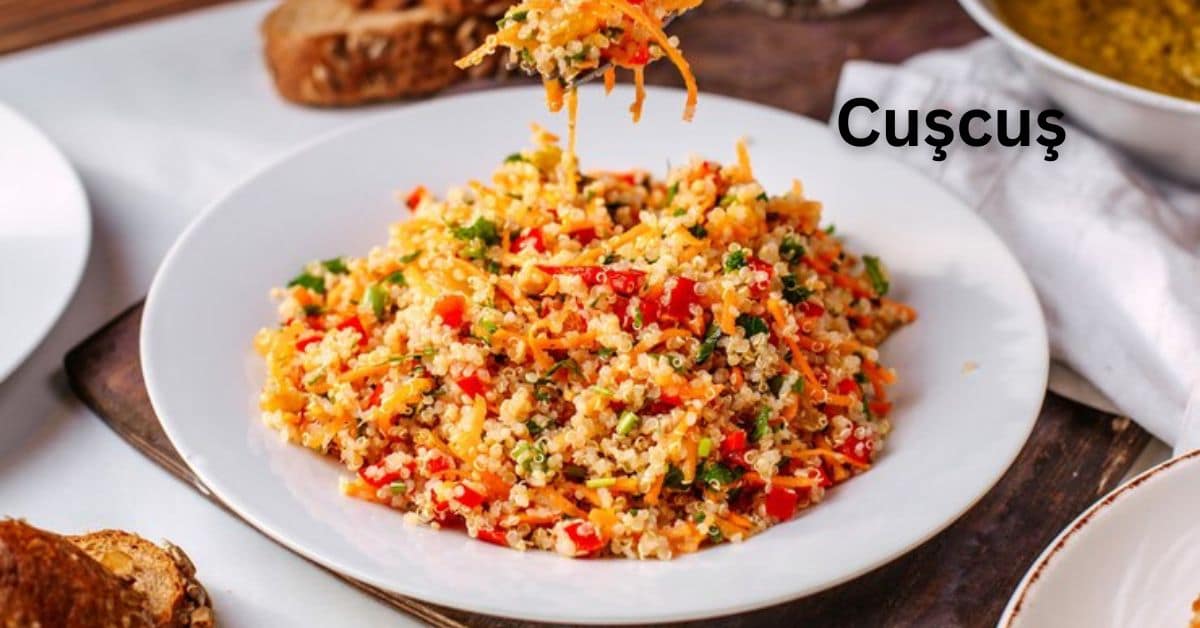Cuşcuş, often called the food so nice they named it twice, is a traditional North African dish made from steamed semolina wheat granules. Originating from the Maghreb region, it has gained popularity worldwide for its versatility, ease of preparation, and nutritional benefits. This article delves into the rich history, various types, health benefits, and delightful recipes of cuşcuş, offering a comprehensive guide for both novices and seasoned cooks.
Contents
- 1 Types and Varieties of Cuşcuş
- 2 Nutritional Profile of Cuşcuş
- 3 Health Benefits of Cuşcuş
- 4 Common Ingredients and Seasonings for Cuşcuş
- 5 Traditional Cuşcuş Recipes
- 6 Modern Cuşcuş Recipes
- 7 Cultural Significance of Cuşcuş
- 8 Preparation and Cooking Methods
- 9 Serving Suggestions
- 10 Popular Cuşcuş Dishes Around the World
- 11 FAQs about Cuşcuş
- 12 Conclusion
Types and Varieties of Cuşcuş
Traditional Cuşcuş: Traditional cuşcuş is the most common variety, made from semolina wheat. It is typically steamed and served with a stew of meat and vegetables. The small, light, and fluffy grains provide a perfect base for various dishes.
Israeli Cuşcuş: Also known as pearl cuşcuş, Israeli cuşcuş is more significant and rounder than the traditional type. It is made from hard wheat flour and is toasted, giving it a unique nutty flavor and chewy texture. This variety is prevalent in salads and as a side dish.
Lebanese Cuşcuş: Lebanese cuşcuş, or moghrabieh, consists of even larger grains compared to Israeli cuşcuş. It is often used in hearty stews and soups, providing a substantial texture that holds up well to long cooking times.
Whole Wheat Cuşcuş: For those seeking a healthier alternative, whole wheat cuşcuş offers more fiber and nutrients. Made from whole wheat flour, it retains more of the grain’s natural goodness, making it a nutritious option for a balanced diet.
Gluten-Free Cuşcuş: With the rise in gluten sensitivities and celiac disease, gluten-free cuşcuş options have become more available. These are typically made from alternative grains like corn, rice, or quinoa, providing a safe and tasty option for those avoiding gluten.
Nutritional Profile of Cuşcuş
Cuşcuş is a nutritious addition to any meal, offering a range of health benefits. It is primarily composed of carbohydrates, providing a quick source of energy. Additionally, cuşcuş contains essential nutrients like protein, fiber, vitamins, and minerals.
Macronutrient Content
A typical serving of cuşcuş (about one cup cooked) contains approximately 176 calories, 36 grams of carbohydrates, 6 grams of protein, and less than 1 gram of fat. This makes it a low-fat, high-energy food that fits well into various dietary plans.
Micronutrient Content
Cuşcuş is also a good source of several essential micronutrients, including selenium, manganese, and B vitamins. Selenium is particularly notable for its antioxidant properties, which help to protect cells from damage and support a healthy immune system.
Health Benefits
Cuşcuş offers numerous health benefits, making it a valuable addition to a balanced diet.
Health Benefits of Cuşcuş
- Rich in Selenium: One of the standout nutritional features of cuşcuş is its high selenium content. Selenium is crucial in maintaining metabolic function and has powerful antioxidant properties that help prevent cellular damage.
- High in Fiber: Whole wheat cuşcuş, in particular, is a good source of dietary fiber. Fiber aids in digestion helps maintain bowel health and can help lower cholesterol levels.
- Low in Fat: Cuşcuş is naturally low in fat, making it an excellent choice for those looking to reduce their fat intake without sacrificing flavor or satiety.
- Supports Weight Loss: Due to its low calorie and high protein content, cuşcuş can be a beneficial food for those aiming to lose weight. The protein content helps increase feelings of fullness and reduces overall calorie intake.
- Promotes Heart Health: The fiber and low-fat content of cuşcuş contribute to heart health by helping to lower cholesterol levels and maintain healthy blood pressure.
Common Ingredients and Seasonings for Cuşcuş
Cuşcuş is a versatile dish that pairs well with various ingredients and seasonings.
Spices and Herbs
Traditional spices used in cuşcuş dishes include cumin, coriander, turmeric, cinnamon, and paprika. Fresh herbs like parsley, cilantro, and mint also add flavor.
Vegetables
A wide range of vegetables can be added to cuşcuş, including bell peppers, carrots, zucchini, tomatoes, and onions. These add color, texture, and nutritional value to the dish.
Proteins
Cuşcuş can be paired with various proteins such as lamb, chicken, beef, or fish. Chickpeas, lentils, and tofu are excellent vegetarian options.
Fruits and Nuts
Dried fruits like raisins, apricots, dates, and nuts like almonds and pine nuts add a delightful sweetness and crunch to cuşcuş dishes.
Traditional Cuşcuş Recipes
Moroccan Cuşcuş: Moroccan cuşcuş is perhaps the most famous variation. It is traditionally made with lamb or chicken, vegetables, and a blend of aromatic spices. The dish is often served with a spicy harissa sauce on the side.
Algerian Cuşcuş: Algerian cuşcuş features a rich tomato-based sauce typically made with lamb or chicken, chickpeas, and various vegetables. It is a hearty and flavorful dish that showcases Algeria’s rich culinary traditions.
Tunisian Cuşcuş: Tunisian cuşcuş is known for its spicy flavor. It often incorporates harissa paste and a variety of hot peppers. It is commonly made with lamb, fish, or chicken, along with vegetables and chickpeas.
Libyan Cuşcuş: Libyan cuşcuş is usually served with a lamb or beef stew flavored with spices and tomatoes. It often includes vegetables like pumpkin and potatoes, making it a substantial and comforting meal.
Modern Cuşcuş Recipes
Mediterranean Cuşcuş Salad
This refreshing salad combines cuşcuş with fresh vegetables like cucumbers, tomatoes, bell peppers, feta cheese, and olives. It is dressed with a simple lemon and olive oil vinaigrette, making it a perfect light meal or side dish.
Cuşcuş with Roasted Vegetables
Roasting vegetables like zucchini, bell peppers, and eggplant brings out their natural sweetness, which pairs beautifully with the fluffy cuşcuş—a sprinkle of fresh herbs and a drizzle of balsamic glaze complete this dish.
Spicy Cuşcuş with Chicken
This dish features cuşcuş cooked with a spicy tomato sauce, chicken, and a blend of spices. It is a warming and satisfying meal, perfect for a cozy dinner.
Cuşcuş Breakfast Bowl
Cuşcuş isn’t just for lunch or dinner—it can also make a delicious breakfast. This bowl combines cuşcuş with fresh fruit, yogurt, and a drizzle of honey for a nutritious and energizing start to the day.
Cultural Significance of Cuşcuş
Cuşcuş is unique in many cultures, particularly in North Africa and the Middle East.
Cuşcuş in North African Culture
In Morocco, Algeria, and Tunisia, cuşcuş is more than just a meal—it symbolizes hospitality and community. It is often served at family gatherings, religious festivals, and special occasions.
Cuşcuş in Middle Eastern Cuisine
Cuşcuş is also popular in Middle Eastern countries and is often served with various meats and vegetables. It is a staple food that reflects the region’s rich culinary traditions.
Festivals and Celebrations Featuring Cuşcuş
In many cultures, cuşcuş is a central part of celebrations and festivals. It is a dish that brings people together and is often shared communally, symbolizing unity and togetherness.
Preparation and Cooking Methods
Preparing cuşcuş can be quick and easy or more traditional and time-consuming, depending on the method used.
Traditional Steaming Method
Traditional cuşcuş is steamed multiple times in a unique pot called a couscoussier. This method ensures the grains are light and fluffy. The cuşcuş is often rubbed with olive oil and salt before steaming to enhance flavor.
Quick Cooking Method
Instant cuşcuş is widely available for quicker preparation. It only requires a few minutes of steaming or soaking in hot water, making it a convenient option for busy cooks.
Tips for Perfect Cuşcuş
To achieve the perfect cuşcuş, fluff the grains with a fork after cooking to separate them. Adding olive oil or butter can also enhance the texture and flavor.
Serving Suggestions
Cuşcuş is incredibly versatile and can be served in many ways.
Side Dishes
Cuşcuş is an excellent side dish for grilled meats, fish, or vegetables. It can be flavored simply with herbs and spices or combined with other ingredients for more complexity.
Main Courses
As a main course, cuşcuş can be paired with a hearty stew or sauce. Proteins like chicken, lamb, or chickpeas can make it a satisfying meal.
Salads
Cuşcuş salads are a popular choice for a light and refreshing dish. They can be customized with various vegetables, herbs, and dressings.
Soups
Cuşcuş can also be added to soups, providing a hearty and filling element. It works particularly well in vegetable or chicken soups.
Popular Cuşcuş Dishes Around the World
Cuşcuş Royale is a French variation that mixes meats like lamb, chicken, and merguez sausage, served with vegetables and a flavorful broth. It is a rich and indulgent dish that showcases the versatility of cuşcuş.
Vegetable Cuşcuş
Vegetable cuşcuş is a popular vegetarian option. It features a variety of seasonal vegetables, often cooked with spices and herbs, to enhance their natural flavors.
Seafood Cuşcuş
In coastal regions, seafood cuşcuş is a beloved dish. It combines cuşcuş with fresh fish, shrimp, and other seafood, often cooked with tomatoes and spices.
Sweet Cuşcuş Dishes
Cuşcuş can also be used in sweet dishes. It can be cooked with milk, sweetened with honey or sugar, and flavored with cinnamon and dried fruits for a delicious dessert or breakfast.
FAQs about Cuşcuş
Q: What is cuşcuş made from?
A: Cuşcuş is traditionally made from semolina wheat. However, variations are made from whole wheat, corn, rice, or quinoa to accommodate different dietary needs.
Q: Is cuşcuş gluten-free?
A: Traditional cuşcuş is not gluten-free as it is made from wheat. However, gluten-free versions are made from alternative grains like corn or rice.
Q: How to store cuşcuş?
A: Uncooked cuşcuş should be stored in an airtight container in a cool, dry place for up to four days. Cooked cuşcuş can be stored in the refrigerator for up to four days.
Q: Can cuşcuş be eaten cold?
A: Yes, cuşcuş can be eaten cold. It is often used in salads and can be refreshing, especially during warmer months.
Q: How to reheat cuşcuş?
A: To reheat cuşcuş, you can use a microwave or stovetop. Add a little water or broth to prevent it from drying out, and heat until warm.
Conclusion
Cuşcuş is a versatile and nutritious dish that has earned its place in kitchens worldwide. From its traditional roots in North Africa to its modern adaptations, cuşcuş offers a delightful culinary experience. Whether you’re preparing a simple side dish or a hearty main course, cuşcuş will impress with its light, fluffy texture and ability to absorb flavors. Embrace the culinary possibilities of cuşcuş and explore the rich heritage and modern innovations this remarkable dish offers.
Latest Post!
- The Ultimate Guide to Buy WoW Gold Classic Anniversary
- Eth Oxford: A Detailed Note
- www. disquantified org: A Detailed Guide
- Business Insight ShopNaclo: All You Need to Know
- World of Warcraft 20th Anniversary: Reliving The Burning Crusade Classic
- Kitchen Remodeling Trends for Coastal Homes in Fort Lauderdale: Embrace the Ocean Vibe

Sarah Wilson, an accomplished writer and seasoned blogger, weaves compelling narratives that transport readers to new and uncharted worlds. With a talent for vivid storytelling and thoughtful insight, her work leaves a lasting mark, enchanting both the imagination and intellect.






